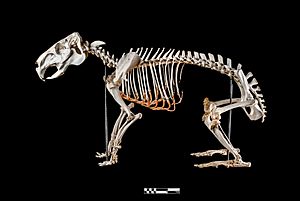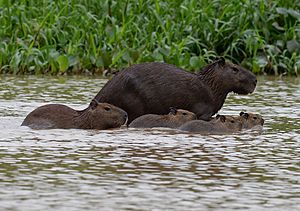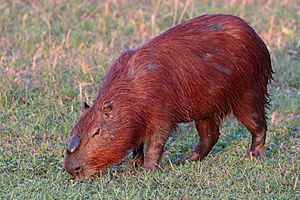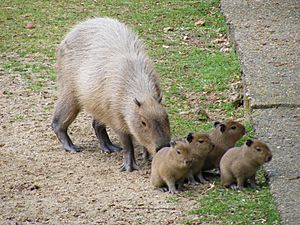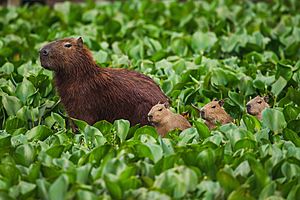Capybara
Quick facts for kids Capybara |
|
|---|---|
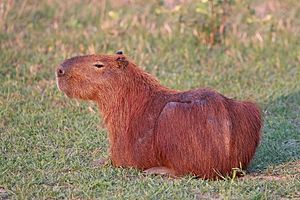 |
|
| At Pantanal, Brazil | |
| Conservation status | |
| Scientific classification | |
| Genus: |
Hydrochoerus
|
| Species: |
hydrochaeris
|
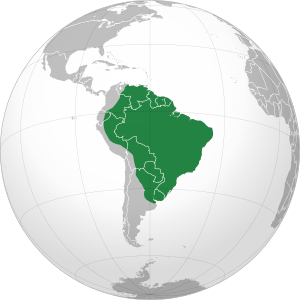 |
|
| Native range | |
| Synonyms | |
|
Sus hydrochaeris Linnaeus, 1766 |
|
The capybara (also called the greater capybara) is the biggest rodent in the world! It's a type of giant cavy and lives in South America. Capybaras are related to guinea pigs and rock cavies. They are also distant relatives of animals like the agouti and the chinchilla.
Capybaras love to live in savannas and thick forests. You'll always find them near water, like rivers or lakes. They are very social animals and often live in groups of 10 to 20. Sometimes, especially when water is scarce, groups can grow to 100 capybaras! People sometimes hunt capybaras for their meat and skin. But don't worry, they are not an endangered species.
Contents
What Capybaras Look Like
Capybaras have a strong, barrel-shaped body and a short head. Their fur is reddish-brown on top and lighter, yellowish-brown underneath. Unlike many rodents, their sweat glands are on the hairy parts of their skin. They don't have soft underfur, and their outer fur is pretty much the same all over.
Adult capybaras are about 106 to 134 cm (3.48 to 4.40 ft) long. They stand around 50 to 62 cm (20 to 24 in) tall at their shoulders. Most capybaras weigh between 35 to 66 kg (77 to 146 lb). Females are usually a little heavier than males. The heaviest wild capybara ever recorded weighed 91 kg (201 lb)!
Capybaras have slightly webbed feet, which helps them swim. They also have tiny, almost invisible tails. Their back legs are a bit longer than their front legs. They have three toes on their back feet and four toes on their front feet. Their noses are blunt, and their eyes and ears are placed high on their heads. This helps them see and hear when they are mostly underwater.
Where Capybaras Live and What They Do
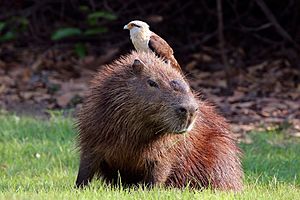
Capybaras are semiaquatic mammals, meaning they spend a lot of time in water. You can find them in almost every country in South America, except Chile. They prefer to live in thick forests near water sources like lakes, rivers, swamps, and ponds. They also live in flooded grasslands and along rivers in rainforests. Capybaras have even started to do well on cattle ranches. They usually roam around an area of about 10 hectares (25 acres).
What Capybaras Eat and Who Eats Them

Capybaras are herbivores, which means they only eat plants. They mostly graze on grasses and water plants. They also eat fruits and tree bark. They are picky eaters, often choosing specific types of leaves and ignoring others nearby. During the dry season, when fewer plants are available, they eat a wider variety. For example, they might eat more reeds when grass is scarce.
Capybaras chew their food by grinding it back and forth, not side to side. They also sometimes bring food back up to chew it again, much like cows do. This helps them get all the nutrients from tough plants.
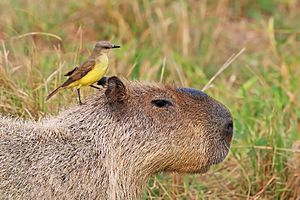
Just like guinea pigs, capybaras cannot make their own vitamin C. If they don't get enough vitamin C, they can develop gum problems, similar to scurvy in humans.
In the wild, capybaras can live for about 8 to 10 years. However, they often live less than four years because of predators. Large cats like jaguars and pumas hunt them. Birds like eagles and reptiles like caimans also prey on capybaras. The green anaconda especially likes to hunt capybaras.
How Capybaras Live Together
Capybaras are very social animals. While some might live alone, most live in groups of about 10 to 20. These groups usually have a few adult males, several adult females, and many young capybaras. During the dry season, when water is hard to find, many groups might gather together. This can create very large groups of 50 or even 100 capybaras around the remaining water sources.
Male capybaras work to keep the group together and decide who is in charge. They can make barks that sound like dogs when they feel threatened or when females are guiding their young. They also use special scent marks to show where their territory is.
Capybara Babies
Capybaras only mate in the water. If a female doesn't want to mate with a male, she will either go underwater or leave the water. The dominant males in a group are very protective of the females. It's harder for a male to watch all the females in a very large group.
A mother capybara usually has about four babies at a time, but she can have anywhere from one to eight. The babies are born on land. The mother rejoins her group just a few hours after giving birth. The newborn capybaras can join the group as soon as they can move around. Within a week, the young capybaras can start eating grass. However, they continue to drink milk from any female in the group until they are about 16 weeks old. The young capybaras often form their own little group within the main group. Sometimes, other females in the group will help care for the babies, which is called Alloparenting.
Daily Life of a Capybara
Capybaras are good on land, but they are truly at home in the water. They can even sleep in the water, keeping only their noses out so they can breathe! As the day gets hotter, they like to cool off by wallowing in the water. Then, in the late afternoon and early evening, they come out to graze on grass. They also enjoy rolling around in the mud. They usually rest around midnight and then start grazing again before the sun comes up.
Capybaras and Humans
Capybaras are not considered an endangered species. Their numbers are steady in most parts of South America. In some areas, people hunt them for their meat and skins. Sometimes, they are killed by farmers who think capybaras eat too much grass that their livestock could use. However, in some places, capybaras are farmed, which helps protect their wetland homes. They can breed quickly, which also helps their populations stay strong.
Capybaras have adapted well to living near cities in South America. You can often see them in zoos and parks.
Capybaras in Pop Culture
In the early 2020s, capybaras became very popular on the internet as memes. You might have seen videos of capybaras in different funny situations with the song "After Party" by Don Toliver playing. This made them incredibly popular. Because of a line in that song, capybaras are also linked to the phrase "Ok I pull up."
Cool Facts About Capybaras
- Capybaras can live for up to 12 years in zoos, which is more than twice as long as they usually live in the wild!
- Their common name comes from the Tupi language, ka'apiûara , which means "one who eats slender leaves" or "grass-eater."
- Capybaras are usually calm and might let humans pet them or give them food. However, it's generally best not to touch them too much, as they can carry ticks that might spread diseases.
- They are amazing swimmers and can hold their breath underwater for up to five minutes!
- Capybaras eat their own poop! This helps them get all the good bacteria they need to digest the tough cellulose in grass. It also helps them get the most protein and vitamins from their food.
- Their front teeth and cheek teeth never stop growing. This is important because eating tough grasses wears them down constantly.
- Even though it's against the law in some places, capybaras are sometimes kept as pets in the United States.
- In Japan, capybaras are a big attraction. They became very popular there because of a cartoon character called Kapibara-san.
- You can find a picture of a capybara on the 2-peso coin in Uruguay.
See also
 In Spanish: Capibara para niños
In Spanish: Capibara para niños
- Josephoartigasia monesi, an extinct species that was the largest known rodent ever!




